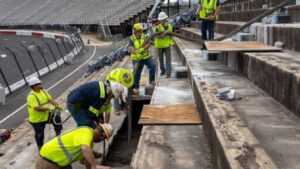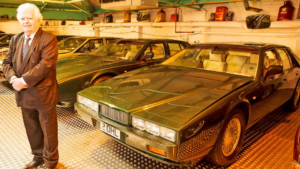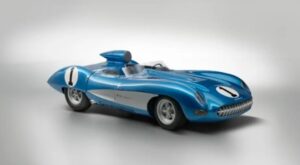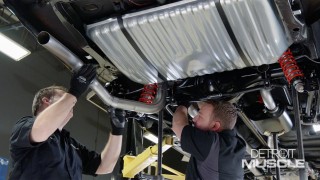The Incredible Story of Converting Bristol Speedway To Dirt Took More than Just Dirt
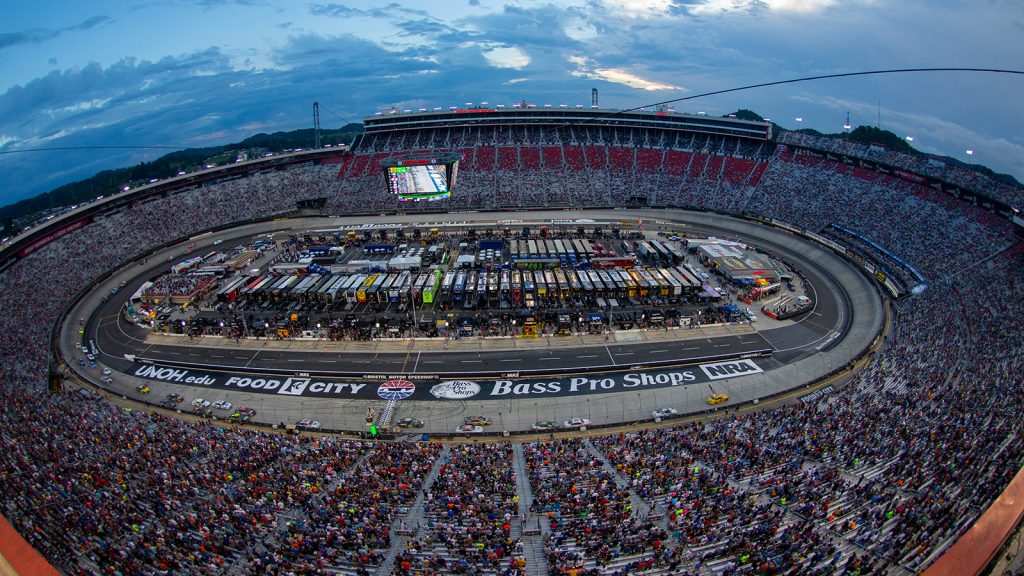
“You really look back to the early stages of NASCAR, the roots of our sport. Do something bigger and better for the race fans.”
Senior Vice President, Steve Swift, is part of the innovation business, which is reflected in his title, but also his resume as senior vice president of operations and development at Speedway Motorsports, Inc. However, most around him believe that “director of fun” is a more appropriate title.
Swift has been responsible for overseeing some extreme ideas in recent motorsports history, and he’s logged over 35,000 miles visiting numerous dirt tracks across the United States preparing for his latest project.
He’s the reason behind the world’s only four-lane drag strip at zMax Dragway at Charlotte Motor Speedway, taking that idea a decade later and applying it to the Las Vegas Motor Speedway. When he was challenged to create a stadium road course out of Charlotte Motor Speedway, Swift came up with the Roval.
The world’s largest center-hung LED video screen in the world at Bristol and the sister jumbotrons at Texas and Charlotte Motor Speedway also fell under his scope.
With a past of developing the unique and delivering, SMI President and CEO Marcus Smith trusted him with building a better version of the temporary dirt track that once replaced the concrete surface at Bristol. However, this time was for a NASCAR Cup Series race. For Swift? No pressure – just another day in the office.
Swift, a Bristol native, is on the record saying that “as an engineer, anytime you get to play in the mud while you’re on the job, it’s a good day in my book. I’ve been fortunate to work on some great projects during my time with Speedway Motorsports. When you work for visionaries like Marcus and Bruton Smith you know you’re going to be engaged in some interesting projects.”
“Converting Bristol Motor Speedway to dirt is a challenging but fun project.”
This isn’t the first time a project like this has been completed. Bristol hosted the World of Outlaws in 2000 and 2001, but a lot has changed to both simplify and complicate the process in the following two decades. An event like this hasn’t taken place since 2001 because it’s a complex and expensive project with a lot of moving parts. The cost has yet to be made available to the public.
In total, it required 23,000 cubic yards of dirt, which comes in the form of 2,300 truckloads of compacted dirt. It’s then placed in specific locations using Global Satellite Positioning (GPS) equipment on the graders and bulldozers working on the job. This is one example of how they’ve streamlined the process from 20 years ago.
“There is a GPS system on our dirt moving equipment that’s talking to roughly 26 to 30 satellites at a time that relay positioning information in correlation to where on the track the blade needs to be,” according to Swift. “With the GPS, it gives us accuracy within five-hundredths of an inch. You are talking about the fineness of a hair. It’s an amazing technology, actually.”
Another piece of the puzzle that’s changed considerably over the past 30 years is the concrete surface below the temporary dirt track. In 2007, a resurfacing reduced the banking from 36 degrees to a 24-28 progressively steeped track boasting wider aprons.
The 2000-01 dirt track had 21 degrees banking once the project wrapped up. This time around, nine to ten feet of dirt was installed to bring the banking to 19 degrees. The goal? To create more competitive racing. Without the SAFER Barrier, the entire surface on the track will be 50′ wide, which was done through additional advances by the simulation department.
The project started in January when a substantial amount of sawdust was spread around the half-mile racing surface. “The reason this was done was to make sure when we clean the track up that we have a way to get it off without staining the concrete and get the track ready for the NASCAR Night Race in September,” says Swift. “It also helps with the cleanup.”
The next step was the construction team adding a layer of fill dirt. It was the same clay used on the 2000 and 2001 World of Outlaws racing surfaces at Bristol. The clay was stored at the facility a few miles from the track and hauled in. The second layer came from across the street at Gentry Campground.
The racing surface was given the most consideration, which is why Swift devoted so much air travel in the past six months conducting research. “Visited a lot of dirt tracks,” said Swift. “Went to a lot of dirt races to educate ourselves a bit more on all the nuances behind dirt. Fortunately, we’re dealing with nice, good red dirt that we have in northeast Tennessee.”
The key to a great dirt track is good clay. For those new to dirt racing, sand contributes to tire wear and leads to a dusty experience when racing. It also doesn’t hold moisture. Silt isn’t compactable and won’t allow for a sturdy racing surface. So minimizing sand and silt is a key dirt mixture, but there’s more to it.
“It’s the alluvial and microbial that are inside the dirt,” according to Swift. “So that’s all the weird stuff that you hear, like horse manure that makes it live instead of dead dirt. I don’t have a PhD in the stuff, so that’s why we called Mr. Hall for information on what we found. The pH balance of the dirt must be a certain level to make for good racing. Those levels were good at the location we had started digging out of.”
Baker’s Construction in Bluff City, Tennessee, was responsible for constructing the track. Their equipment was provided by Meade Tractor from close by Johnson City. Tony Harper of Line & Grade, Inc. of Ackworth, Georgia designed the dirt track.
The Cup Series race will be the first such race since 1970 to take place on a dirt surface and is scheduled for 250 laps. It’ll utilize heat races and passing points to determine the starting lineup.
Once the racing concludes, the clean-up will commence in advance of the NASCAR Night Race weekend in September. Tearing the dirt apart isn’t as simple as one might think, but it’s just another day in the office for the director of fun.
Want to read more articles like this?
Join the PowerNation Email NewsletterRead More from PowerNation
- Chapters
- descriptions off, selected
- captions off, selected
- default, selected
This is a modal window.
